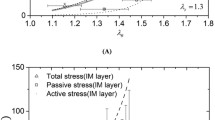Abstract
A biphasic, anisotropic model of the deformable aortic wall in combination with computational fluid dynamics is used to investigate the variation of shear stress over smooth muscle cells (SMCs) with transmural pressure. The media layer is modeled as a porous medium consisting of SMCs and a homogeneous porous medium of interstitial fluid and elastin, collagen and proteoglycans fibers. Interstitial fluid enters the media through fenestral pores, which are distributed over the internal elastic lamina (IEL). The IEL is considered as an impermeable barrier to fluid flow except at fenestral pores. The thickness and the radius of aortic wall vary with transmural pressure ranging from 10 to 180 mm Hg. It is assumed that SMCs are cylinders with a circular cross section at 0 mm Hg. As the transmural pressure increases, SMCs elongate with simultaneous change of cross sectional shape into ellipse according to the strain field in the media. Results demonstrate that the variation of shear stress within the media layer is significantly dependent on the configuration and cross sectional shape of SMCs. In the staggered array of SMCs, the shear stress over the first SMC nearest to the IEL is about 2.2 times lower than that of the square array. The shear stress even over the second nearest SMC to the IEL is considerably higher (about 15%) in the staggered array. In addition to configuration and cross sectional shape of SMCs, the variation of structural properties of the media layer with pressure and the sensitivity of the local shear stress to the minimum distance between SMCs and the IEL (reducing with transmural pressure) between SMCs and the IEL are studied. At 180 mm Hg, the ratio of the local shear stress of the nearest SMC to that of the second nearest SMC is 4.8 in the square array, whereas it reduces to about 1.8 in the staggered array. The importance of the fluid shear stress is associated with its role in the biomolecular state of smooth muscle cells bearing the shear stress.







Similar content being viewed by others
References
Asakura T, Karino T (1990) Flow patterns and spatial distribution of atherosclerotic lesions in human coronary arteries. Circ Res 661:045–1066
Baldwin AL, Wilson LM, Simon BR (1992) Effect of pressure on hydraulic conductance. Arterioscler Thromb 121:63–171
Dabagh M, Jalali P, Sarkomaa P (2007) Effect of the shape and configuration of smooth muscle cells on the diffusion of ATP through the arterial wall. Med Biol Eng Comput 45:1005–1014
Dabagh M, Jalali P, Sarkomaa P, Konttinen YT (2009) Molecular transport through arterial wall composed of smooth muscle cells and a homogeneous fiber matrix. J Porous Media (in press)
Friedman MH, Hutchins GM, Bargeron CB, Deters OJ, Mark FF (1981) Correlation between intimal thickness and fluid shear in human arteries. Atherosclerosis 394:25–436
Garanich JS, Pahakis M, Tarbell JM (2005) Shear stress inhibits smooth muscle cell migration via Nitric-mediated downregulation of matrix metalloproteinase-2 activity. Am J Physiol Heart Circ Physiol 288:H2244–H2252
Huang Y, Jan KM, Rumschitzki D, Shu C, Weinbaum S (1998) Structural changes in rat aortic intima due to transmural pressure. Trans ASME J Biomech Eng 1204:76–483
Huang Y, Rumschitzki D, Shu C, Weinbaum S (1997) A fiber matrix model for the filtration through fenestral pores in a compressible arterial intima. Am J Physiol Heart Circ Physiol 272:H2023–H2039
Johnson M, Tarbell JM (2001) A biphasic, anisotropic model of the aortic wall. J Biomech Eng Trans ASME 123:52–57
Klanchar M, Tarbell JM (1987) Modeling water flow through arterial tissue. Bull Math Biol 496:51–669
Kohler TR, Jawien A (1992) Flow affects development of intimal hyperplasia after arterial injury in rats. Arterioscler Thromb 129:63–971
Lai W, Mow V (1980) Drag induced compression of articular cartilage during a permeation experiment. Biorheology 17:111–123
Papadaki M, McIntire LV, Eskin SG (1996) Effects of shear stress on the growth kinetics of human aortic smooth muscle cells in vitro. Biotech Bioeng 505:55–561
Simon B, Kaufmann M, McAfee M, Baldwin A, Wilson L (1998) Identification and determination of material properties for porohyperelastic analysis of large arteries. ASME J Biomech Eng 120:188–194
Sterpetti AV, Cucina A, Santoro D’Angelo L, Cardillo B, Cavallaro A (1993) Shear stress modulates the proliferation rate, protein synthesis, and mitogenic activity of arterial smooth muscle cells. Surgery 1136:91–699
Tada S, Tarbell JM (2000) Interstitial flow through the internal elastic lamina affects shear stress on arterial smooth muscle cells. Am J Physiol Heart Circ Physiol 278:H1589–H1597
Tada S, Tarbell JM (2002) Flow through the internal elastic lamina affects shear stress on smooth muscle cells (3D simulations). Am J Physiol Heart Circ Physiol 282:H576–H584
Tedgui A, Lever MJ (1984) Filtration through damaged and undamaged rabbit thoracic aorta. Am J Physiol 274:H784–H791
Ueba H, Kawakami M, Yaginuma T (1997) Shear stress as an inhibitor of vascular smooth muscle cell proliferation: role of transforming growth factor-β1 and tissue-type plasminogen activator. Arterioscler Thromb Vasc Biol 171:512–1516
Wolinsky H, Glagov S (1964) Structural basis for the static mechanical properties of the aortic media. Circ Res 14:400–413
Acknowledgments
Authors would like to acknowledge the financial support of this work by the Academy of Finland (Grant No. 112908, 110852, 123938). Authors gratefully acknowledge valuable remarks received from Prof. J. M. Tarbell, Dr. Mark Johnson, and Dr. Shigeru Tada.
Author information
Authors and Affiliations
Corresponding author
Rights and permissions
About this article
Cite this article
Dabagh, M., Jalali, P., Konttinen, Y.T. et al. Distribution of shear stress over smooth muscle cells in deformable arterial wall. Med Biol Eng Comput 46, 649–657 (2008). https://doi.org/10.1007/s11517-008-0338-7
Received:
Accepted:
Published:
Issue Date:
DOI: https://doi.org/10.1007/s11517-008-0338-7




